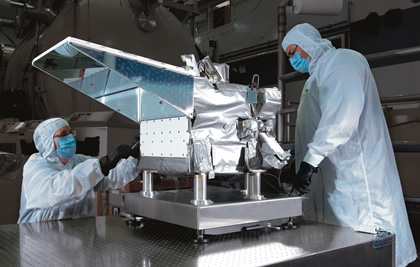Engineering, Technology and Mission Assurance
Ensuring Customer Success
-

Raytheon’s Aerosol Polarimetry Sensor was designed to collect global aerosol data for climate scientists during NASA’s Glory mission. The three-year mission aims to ascertain the ratios of different species of short-lived aerosols in earth’s atmosphere to further understand their role in global and regional climate change. This new information will also enable policy makers to formulate responses to climate change based on a more complete understanding of the global processes that contribute to it.
-
Raytheonís Engineering, Technology and Mission Assurance (ET&MA) organization acts as an engine of innovation and an enabler of value creation and Mission Assurance. It provides the framework to support program excellence, business and customer success. Among its goals is to push the technology boundary and to provide the most innovative solutions for our customers and our communities. Its commitment to excellence is demonstrated across a wide spectrum of technology solutions for diverse problems facing our warfighters and our communities at home.
Global Broadcast Service
The Global Broadcast Service (GBS) provides high-speed, multimedia broadcasts of mission-essential information to military and government decision makers, while also helping our nationís warfighters stay in touch with the events at home during their mission. Developed and operated by Raytheon, GBS delivers intelligence and situational awareness data to military forces, whether they are in the mountains of Afghanistan, on warships in the Pacific or in submarines hundreds of feet below the surface. Using our system, thousands of U.S. troops, including those deployed to the most remote and rugged locations, also were able to take a break from their duties to watch the presidential inauguration and Super Bowl XLIII.

-
Security Systems
To provide enhanced security and situational awareness during the largest single-day sporting event in the world — the Indianapolis 500 — a Raytheon-deployed system was used to augment security operations and communications. It consisted of a 17-meter aerostat equipped with a sensor package that relayed real-time information to the command center within the speedway.
Tempwave™ System
As part of our strategy to apply defense technologies to address sustainability issues, Raytheon is taking the ďfight to the frostĒ with a new system using radio frequency technology adapted from the companyís legendary radar systems. Raytheonís Tempwave radiant heating system offers a more efficient way to warm crops and avoid the adverse effects of frost on the growing season. The Tempwave system uses radio frequency waves to deliver energy directly to the crop without heating the air. It works to prevent freeze damage, uses no water, emits no smoke and is silent in operation.
-
Environmental Solutions
Raytheonís environmental solutions leverage 40 years of proven performance to keep customers one step ahead of weather, water and climate forces. With domain knowledge in complex systems-of-systems problems, we help customers define climate issues, provide actionable information, and develop tools to measure outcomes. Our innovative sensing, communications, processing and visualization technologies quickly and reliably enable decision makers to understand the world around us — on land, in the air, at sea, under the sea and in space.
We have delivered innovative environmental solutions from the deepest reaches of the Amazon to the depths of outer space, successfully partnering with government, academia and industry along the way. Raytheon capabilities and programs during 2009 in this area include:
- The Advanced Weather Interactive Processing System used by the National Oceanic and Atmospheric Administration/National Weather Service to analyze and disseminate operational weather data, including time-sensitive, high-impact warnings.
- Raytheonís Aerosol Polarimetry Sensor will increase our understanding of the impact of aerosols on global climate change when delivered into space during an upcoming launch for NASAís three-year Glory mission.
